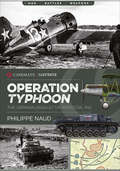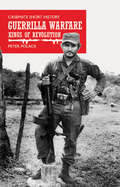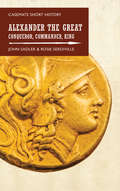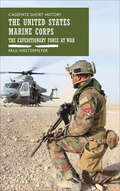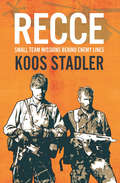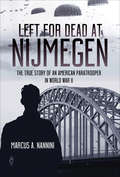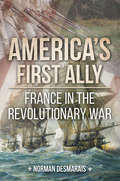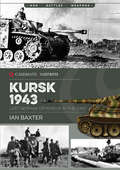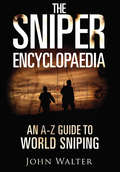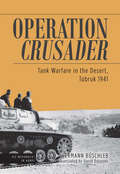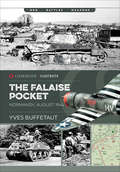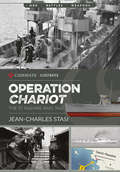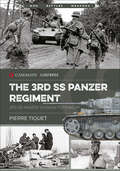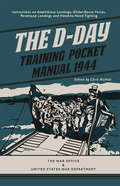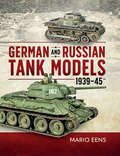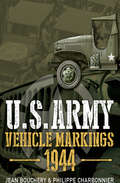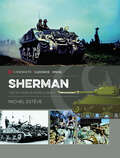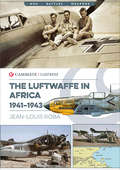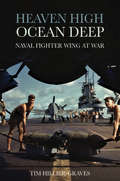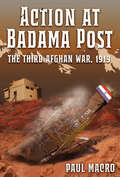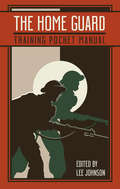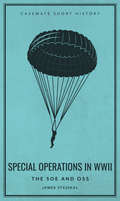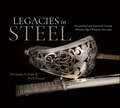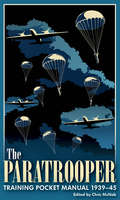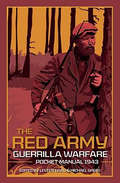- Table View
- List View
Operation Typhoon: The German Assault on Moscow, 1941 (Casemate Illustrated)
by Philippe NaudA visual look at the Nazi assault on the Soviet capital in the series that&’s &“a welcome addition . . . targeted at the general World War II enthusiast&” (Globe at War). After the initial successes of Operation Barbarossa, at the end of September 1941, Hitler turned his focus to Moscow, with the unshakeable belief that capturing the capital would knock the Soviets out of the war. On the face of it, it was an unequal matchup in Germany&’s favor, but the picture was, in fact, a great deal more complex; the Germans had suffered very significant losses since the invasion of Russia had begun and had issues with logistics and air support. The Soviets, under the command of Gen. Zhukov, were beginning to be better supplied with reinforcements and were prepared to defend to the death. This volume in the Casemate Illustrated series concentrates on the main German assault of October 1941. Guderian&’s panzer divisions at first made sweeping gains, as they had done so many times before, and large parts of the Red Army were encircled at Vyazma and Bryansk. These successes allowed the Soviets time to regroup, as the encircled armies did not surrender and had to be dealt with. Then, three engagements followed at Mtsensk, Maloyaroslavets and the Mojaisk defense line that proved that the war in the east was not entering its final days, as German high command believed. Illustrated with over 150 photographs, plus profile drawings of tanks, vehicles, and aircraft, this book gives a vivid impression of the situation for both protagonists, and a detailed analysis of the critical days as the fate of Moscow—and perhaps the whole war—hung in the balance.
Guerrilla Warfare: Kings of Revolution (Casemate Short History)
by Peter PolackThis concise history of guerilla warfare presents profiles in combat courage from George Washington to Simón Bolívar, Mao Zedong, and beyond. The concept of guerrilla warfare is centuries old, with Sun Tzu&’s writing on the subject dating back to the sixth century BC. One of the earliest recorded examples of guerrilla tactics deployed by a military leader was the campaign of Roman general Fabius Maximus, who took a course of evasion and harassment against Hannibal&’s columns. Guerilla Warfare is a compendium of prominent guerrilla leaders across the globe, from thirteenth-century Scotland&’s William Wallace to modern-day Sri Lanka&’s Velupillai Prabhakaran. It profiles each leader to analyze their personal history, military tactics, and political strategy. All are home-grown leaders of extended guerrilla campaigns. Many became the first leaders of their liberated countries. Both victories and defeats are included here in an analysis of effective guerrilla tactics as well as counterinsurgency strategies. Today, the labels of insurgent, freedom fighter, and jihadi are fast replacing guerrilla. The old notion of the guerrilla, associated with fights for independence and the end of colonialization, has dimmed with modern and far-reaching religious insurgencies taking their place. This concise history gives a fascinating overview of a once history-altering form of warfare.
Alexander the Great: Conqueror, Commander, King (Casemate Short History)
by John Sadler Rosie SerdivilleAn overview of Alexander&’s life—from his early military exploits to the creation of his empire and the legacy left after his premature death. Alexander was perhaps the greatest conquering general in history. In a dozen years, Alexander took the whole of Asia Minor and Egypt, destroyed the once mighty Persian Empire, and pushed his army eastwards as far as the Indus. No one in history has equaled his achievement. Much of Alexander&’s success can be traced to the Macedonian phalanx, a close-ordered battle formation of sarissa-wielding infantry that proved itself a war-winning weapon. The army Alexander inherited from his father was the most powerful in Greece—highly disciplined, trained, and loyal only to the king. United in a single purpose, they fought as one. Cavalry was also of crucial importance in the Macedonian army as the driving force to attack the flanks of the enemy in battle. A talented commander able to anticipate how his opponent would think, Alexander understood how to commit his forces to devastating effect and was never defeated in battle. He also developed a corps of engineers that utilized catapults and siege towers against enemy fortifications. Alexander led from the front, fighting with his men, eating with them, refusing water when there was not enough, and his men would quite literally follow him to the ends of the (known) world. None of his successors were able to hold together the empire he had forged. Although he died an early death, his fame and glory persist to this day.
The United States Marine Corps: The Expeditionary Force at War (Casemate Short History)
by Paul WestermeyerA concise overview of USMC history from an award-winning author, including photos and a timeline: &“Educational and enjoyable.&” —Booklist Many think of the United States Marine Corps as a second land army, and while it has been employed in that capacity, it is foremost a naval expeditionary force able to seize, secure, and defend advanced naval bases in support of major campaigns. The Corps dates back to the Revolutionary War, but while they served in the conflicts of the nineteenth century, they are famed for their part in the wars of the twentieth century. On the Western Front in World War I they were blooded at Belleau Wood. Between the wars the Corps developed amphibious tactics that were employed to great effect during the Pacific island campaigns during World War II, including the infamous battles of Peleliu, Iwo Jima, and Okinawa. The name of the Corps is forever entwined with the battles of Inchon and Chosin Reservoir in Korea, and Hue and Khe Sanh in Vietnam. The US Marines have continued their expeditionary role to this day, undertaking not only combat operations but also peacekeeping, peace enforcement, humanitarian relief, and short-notification/limited-duration contingency operations. This short history charts the evolution of the Corps as it has adapted to changing combat over two centuries.
Recce: Small Team Missions Behind Enemy Lines
by Koos StadlerA gripping firsthand account of life and combat operations in the elite South African Special Forces, known as Recces, by a veteran Recce officer. The South African Special Forces are one of the most effective—and mysterious—military units in the world. Working in secret on covert operations, the legendary Recces have long fascinated, but little is known about how they operate. Now Koos Stadler, a career officer in the South African Special Forces, shares a revealing chronicle of his life and his experiences in the Border War. Shortly after passing the grueling Special Forces selection course in the early 1980s, Koos Stadler joined the so-called Small Teams group at 5 Reconnaissance Regiment. This sub-unit was made up of two-man teams and was responsible for many secret missions behind enemy lines. Sent to blow up railway lines and enemy fighter jets in south Angola, Stadler and his partner stared death in the face many times.
Left for Dead at Nijmegen: The True Story of an American Paratrooper in World War II (Casemate Illustrated)
by Marcus A. NanniniLeft for Dead at Nijmegen recalls the larger-than-life experiences of an American paratrooper, Gene Metcalfe, who served in the 82nd Airborne during WWII. From his recruitment into the military at Camp Grant to his training with the 501st Paratroop Infantry Regiment at Camp Toccoa, it wasn't until D-Day itself that he first arrived in England to join the 508th PIR. When Metcalfe boarded the C-47 which would drop him at Groesbeek Heights, just outside of Nijmegen, Holland, he was handed a box of twelve dozen condoms by an over-confident British lieutenant. He was to be among the first to jump into what should have been a picture-book meadow, free of German troops. Instead, it was defended by three German anti-aircraft cannon emplacements. As he jumped into a hail of bullets and exploding shells he watched his plane roll over and plummet into the ground. It was at that moment he realized the condoms had either been a bad joke or the planners of Operation Market Garden had seriously underestimated German resistance. Gene was listed as KIA and left for dead by his patrol, who presumed the worst when they saw his injuries from a shell explosion. The rest of his story is equally gripping, as he became a POW held outside Munich, being moved between various camps ridden with disease and a severely undernourished population. Eventually, after making an escape attempt and being captured within sight of the snow-capped Swiss mountains, his camp was liberated by American troops in April 1945. Gene's story is both remarkable for his highly unusual encounter, and his subsequent experiences.
America's First Ally: France in the Revolutionary War (The Pocket Manual Series)
by Norman Desmarais<p>The Revolutionary War historian provides “a comprehensive and accessible guide” to the vital influence France had on America’s path to independence (Publishers Weekly).<p> <p>French support for United States independence was both vital and varied, ranging from ideological inspiration to financial and military support. In this study, historian Norman Desmarais offers an in-depth analysis of this crucial relationship, exploring whether America could have won its independence without its first ally.<p> <p>Demarais begins with the contributions of French Enlightenment thinkers who provided the intellectual frameworks for the American and French revolutions. He then covers the many forms of aid provided by France during the Revolutionary War, including the contributions of individual French officers and troops, as well as covert aid provided before the war began. France also provided naval assistance, particularly to the American privateers who harassed British shipping. Detailed accounts drawn from ships’ logs, court and auction records, newspapers, letters, diaries, journals, and pension applications.<p> <p>In a more sweeping analysis, Desmarais explores the international nature of a war which some consider the first world war. When France and Spain entered the conflict, they fought the Crown forces in their respective areas of economic interest. In addition to the engagements in the Atlantic Ocean, along the American and European coasts and in the West Indies, there are accounts of action in India and the East Indies, South America and Africa.<p>
Kursk 1943: Last German Offensive in the East (Casemate Illustrated #Cis0014)
by Ian BaxterAn illustrated history of World War II&’s largest tank battle that went down near the Russian city. In the summer of 1943, Nazi Germany launched Operation Zitadelle (Citadel), aimed at cutting off Soviet forces in the Kursk salient. This offensive resulted in the Battle of Kursk. Kursk quickly became a fierce contest of attrition, as Wehrmacht and elite Waffen-SS Panzer-Divisions with their powerful Tiger and Panther tanks unsuccessfully tried to hammer their way through the intricate lines of strong Soviet defensive positions. What followed was unabated fighting for two weeks as German units were slowly and systematically ground down in a series of brutal armored battles. During this ferocious fighting the Red Army savagely contested every foot of ground, finally ending German invincibility forever. For the first time in its short history, the blitzkrieg concept had failed. The reverberations caused by the defeat at Kursk were immense, and never again did the German war machine go on the offensive in the East. Stiff defensive action was now the stratagem placed upon the dwindling Panzerwaffe right to the gates of Berlin. With comprehensive captions and text, Kursk 1943 tells the story of this dramatic battle using rare and unpublished photographs, maps, and highly detailed artist profiles. The book reveals the events leading up to the battle in the first half of 1943 and the buildup of forces by both sides before their climatic showdown at Kursk.
The Sniper Encyclopaedia: An A–Z Guide to World Sniping
by John WalterThe Sniper Encyclopaedia is an indispensable alphabetical, topic-by-topic guide to a fascinating subject. This is a comprehensive work that covers virtually any aspect of sniping. The work contains personal details of hundreds of snipers, including not only the best-known — world renowned gurus such as Vasiliy Zaytsev and Chris Kyle — but also many crack shots overlooked by history. Among them are some of more than a thousand Red Army snipers — men and a surprising number of women, who amassed sufficient kills to be awarded the Medal for Courage and, later, the Order of Glory. Some of the best-known victims of snipers are identified, and the veracity of the most popular myths is explored. The book pays special attention to the history and development of the many specialist sniper rifles — some more successful than others — that have served the world’s armies since the American Wars of the nineteenth century to today’s technology-based conflicts. Attention, too, is paid to the progress made with ammunition — without which, of course, precision shooting would be impossible. The development of aids and accessories, from camouflage clothing to laser rangefinders, is also considered. Finally, The Sniper Encyclopaedia examines significant locations and specific campaigns — the way marksman have influenced the course of the individual battles and places which have played a crucial part in the history of sniping, from individual sites to sniper schools and training grounds. The book contains authors’ biographies, a critical assessment of the many books and memoirs on the world of the sniper, and a guide to research techniques.
Operation Crusader: Tank Warfare in the Desert, Tobruk 1941 (Die Wehrmacht im Kampf)
by Hermann BuschlebA 1960s German perspective of the World War II battle in Libya and how the Allied and Axis commanders shaped the course of the action. The port city of Tobruk, Libya, was besieged by German and Italian forces in April, 1941. Following an abortive attempt in June, the Allies made a second attempt in late November, when the Eighth Army launched Operation Crusader, aimed at destroying the Axis armored force then advancing. After several inconclusive engagements, the British 7th Armoured Division was defeated by the Afrika Korps at Sidi Rezegh. Erwin Rommel was then forced to withdraw his troops to the defensive line at Gazala, making the operation the first Allied victory over German land forces in World War II. This account of the tank warfare during Operation Crusader in front of Tobruk in the fall of 1941 examines the roles of commanders in the battles of Operation Crusader, in particular the part of Rommel, who achieved some defensive successes during combat. As well as examining the part of commanders, it discusses the parameters of the battle: the terrain, weather, visibility, logistics, intelligence, and the forces involved. It then narrates the course of the battle, and the result.
The Falaise Pocket: Normandy, August 1944 (Casemate Illustrated #Cis0010)
by Yves BuffetautThe battle of the Falaise Pocket, in August 1944, was the turning point in the Normandy campaign. By early August the German Army was in turmoil: while it was managing to hold back the Allies, the defense involved resources that could not be replaced, and the Allies ruled the skies above. In late July, American troops broke through the American lines and pushed south and east, while British and Canadian troops pushed south. Although unable to counter these offensives, Hitler refused to permit the commander Army Group B, Field Marshal von Kluge, to withdraw. Instead he was ordered to launch a counteroffensive at Mortain, the result being that the Germans ended up further into the Allied envelopment. On 8 August Montgomery ordered that the Allied armies converge on the Falaise area—by 21 August the Allies had linked up and sealed the pocket, trapping around 50,000 Germans inside. While many soldiers did eventually escape the encirclement, the losses were catastrophic and by the end of the month Army Group B had retreated across the Seine, ending the battle of Normandy. This illustrated account examines the battle from the failed offensive at Mortain, looking at both German and Allied perspectives, using maps, diagrams and profiles to complete the story.
Operation Chariot: The St Nazaire Raid, 1942 (Casemate Illustrated #Cis0013)
by Jean-Charles StasiAn illustrated history of the World War II British amphibious attack on a dry dock in the German-occupied French town. At the beginning of 1942, the prospect of Germany&’s Tirpitz, the heaviest battleship ever built by a European navy, patrolling the Atlantic posed a huge threat to the convoys that were the lifeline for Britain. Bombing raids to destroy the ship failed. A more radical plan was conceived to destroy the dry-dock facility at St Nazaire on the French Atlantic coast. Without the use of the only suitable base for the ship, the threat would be neutralized. The plan was to ram the entrance gates with a ship packed with explosives on a delayed fuse. A motorboat armed with torpedoes would fire at the inner gate causing further damage to submarine pens. The troops and crew would then destroy as many dockyard targets as they could and withdraw in fast motor launches that had followed them in. All this was to be achieved under cover of an air raid. HMS Campbeltown, a U.S. lend-lease destroyer, was chosen for the task. On the night of March 27, the raid commenced. The Campbeltown succeeded in lodging its bows in the outer gates. The fuses detonated the explosives in its hold the following day. The dock gates were destroyed. The cost to the Allies was high, but the Tirpitz was never able to leave Norwegian waters. This volume in the Casemate Illustrated series gives a clear overview of the planning and execution of the raid and its aftermath, accompanied by 125 photographs and images, including color profiles and maps.
The 3rd SS Panzer Regiment: 3rd SS Panzer Division Totenkopf (Casemate Illustrated #Cis0011)
by Pierre Tiquet“A fascinating look into the experiences of the men of an elite armored unit that fought on the Eastern Front, written essentially in their own words.” —AMPSThe 3rd SS Panzer Regiment was part of the Totenkopf Division—one of the thirty-eight Waffen-SS divisions active during World War II. Notorious for its brutality, most notably a mass execution of British prisoners in the Battle of France, Totenkopf had a fearsome reputation. The 3rd SS Panzer Regiment was formed in France in late 1942, and transferred to the Eastern Front in early 1943, where it fought for the rest of the war.The regiment participated in a number of battles, and would be reduced and rebuilt a number of times. The panzers of 3rd SS Panzer Regiment fought at Kharkov, took part in Operation Citadel, fought in the battle of Krivoi Rog, and the relief of the Korsun Pocket. The regiment then retreated over the Dniester. They fought in Poland against the Russian advance, before being moved to Hungary where they participated in the attempt to relieve Budapest. They eventually surrendered in Czechoslovakia to the 11th US Armored Division.This book tells the story of the 3rd SS Panzer Regiment through the words of the veterans themselves. Among the veterans whose accounts are included are Walter Weber, a member of a tank crew in 5. Kompanie who recounts their optimism and high spirits at the start of Operation Citadel as the Germans made initial advances, followed by retreat as winter set in and the Russians began to push them back. Unterscharführer Stettner recalls the fierce tank battles and the difficulties advancing across minefields and evading an often well-concealed foe. Corporal Fritz Edelmann records the attempts to relieve Budapest in 1945 that Totenkopf took part in, which ended in encirclement, defeat and surrender to the Americans on May 9, 1945. In addition, it is illustrated with a wealth of contemporary photographs, original documents, and artifacts.
The D-Day Training Pocket Manual, 1944: Instructions on Amphibious Landings, Glider-Borne Forces, Paratroop Landings and Hand-to-Hand Fighting (The\pocket Manual Ser.)
by Chris McNabThe success of the D-Day landings on June 6, 1944 depended on thousands of troops carrying out their mission and the seamless coordination of the amphibious landings with paratrooper and glider assaults. The troops not only had to be trained up ready for their own roles, but to work alongside other troops, often coordinating activities and communicating with other troops while in unfamiliar terrain and under fire. This pocket manual brings together excerpts from Allied manuals used in the preparation for D-Day, including amphibious landings and managing beachheads, pathfinder, paratrooper and glider pilot training, and infantry and armored fighting in the bocage countryside.
German and Russian Tank Models, 1939–45
by Mario EensThis fully illustrated guide offers step-by-step instructions for building detailed models of German and Russian WWII tanks. This comprehensive guide is invaluable for tank modelers of all skill levels. It includes tips and techniques for building models scaled at 1/72, 1/48 and 1/35. Expert modeler Mario Eens also provides a wealth of information on the tools, paints and techniques needed to give your models an accurate and realistic finish. With this guide at your side, you&’ll be able to recreate the Russian T-34 at the time of the battle of Kursk, and the Su-152 in winter camouflage, as well as the German Panzer I in North Africa, and the gigantic Maus, as it might have appeared just after the war ended.
U.S. Army Vehicle Markings, 1944
by Jean Bouchery Philippe CharbonnierAn illustrated guide to the markings used on WWII Era U.S. Army tanks, lorries and Jeeps—an invaluable reference for historians, modelers and collectors. The markings of a 1944 U.S. Army Jeep are an iconic image of American military and the Second World War. But few people know what the distinctive white letters, numbers and symbols actually mean. This uniquely detailed guide explains how these and other markings were integral to organizing the U.S. Army on the move. U.S. Army Vehicle Markings 1944 covers all the markings used on American military vehicles to denote their unit and classification. It also covers tactical markings and the debarkation codes used in the Normandy landings. Hundreds of contemporary photographs are paired with precise color diagrams to show exactly how markings appeared on vehicles, including the exact measurements. The volume explains all the variations in the use of these markings and includes a chapter on the varieties of camouflage used on vehicles.
Sherman: The M4 Tank in World War II (Casemate Illustrated Special)
by Michel Esteve“A superbly organized, well-written, detailed history of the Sherman tank” with hundreds of photos and diagrams included (Armor Magazine).The Medium Tank, M4, better known to the British as the Sherman, was the most widely used medium tank by the United States and western Allies in World War II. Reliable, relatively cheap to produce, and easy to maintain, thousands were distributed to the British Commonwealth and the Soviet Union by the Lend-Lease program. It first saw combat in North Africa, where it outclassed lighter German and Italian tanks. By 1944 the M4 was outgunned by the German heavy tanks, but it still contributed to the fight when deployed in numbers and supported by artillery and fighter-bombers.A detailed insight into the development and deployment of the M4, this book covers the design and construction of the chassis, turret, engine, armaments, and munitions, and differences between the variants of the M4. It covers the difficulties facing the crews who fought in this legendary tank, exploring the training they received and the different combat methods perfected by the Allies, including landing from a landing craft, maneuvering in the bocage of Normandy, and fighting in the snow.Fully illustrated with hundreds of contemporary and modern photographs and detailed diagrams, this complete account provides all the technical details of the construction of the M4, its maintenance and repair, and the logistics required to support it in combat.Whether you are a collector, a modeler, or simply passionate about military history, this book will provide you with an unparalleled insight into the M4.“Period photos, preservation shots, interior details, variant schematics, archival excerpts, armament and ammunition drawings, and more . . . Make it your introduction to this legendary tank family.” —Cybermodeler
Luftwaffe in Africa, 1941–1943 (Casemate Illustrated #Cis0015)
by Jean-Louis RobaThis WWII history examines Nazi air force operations in Egypt and Libya with more than 100 rare wartime photographs. When Mussolini&’s army was defeated on the Libyan-Egyptian border at the beginning of 1941, Adolph Hitler had no choice but to send reinforcements to help his ally. The Luftwaffe deployed an air detachment, first to Sicily, then to North Africa. This volume examines the small expeditionary force, solely devoted to protecting Italian possessions in the Mediterranean and Middle Eastern theater. When General Erwin Rommel launched his Afrika Korps to the east, the Luftwaffe had to go on the offensive to cover the advance. As British air forces were strengthened, German High Command was obliged to send more aerial units into what it had initially considered a peripheral arena of the war. Losses in bombers and fighters were high on both sides. By the time the Allies landed in Morocco and Algeria at the end of 1942, the Wehrmacht&’s fate was sealed. The last German units capitulated in Tunisia in May 1943.
Heaven High, Ocean Deep: Naval Fighter Wing at War
by Tim Hillier-GravesIn 1944, with the invasion of Europe underway and battles in the Atlantic and Mediterranean all but won, the Royal Navy`s strength could be focussed on the Far East and the Pacific where the Japanese were still a long way from defeat. Since the Battle of Midway, in June 1942, the United States had been slowly forcing the Japanese back, but it was a long, bloody process. The Allies needed to combine their forces more effectively if they were to bring the war to an end quickly. In response the Royal Navy massed its ships to add weight to the US Navy. With an attack force of four fleet carriers, and two more on the way, the RN`s role would be significant, but would take time to work up to the state of preparedness of their American cousins. And so a fleet was born for use in the Indian Ocean and, later, the Pacific. From April 1944 to August 1945 they would successfully fight many long, intensive battles. In this time each carrier would contribute greatly to victory, none more so than HMS Indomitable with her 5th Fighter Wing. They would be in thick of the fighting, achieve success and live perilously for a prolonged period, losing many men along the way. It was a war of attrition, which allowed little room for compassion or benevolence. The story told in this book is about the exceptional group of young men, from Britain, Canada, New Zealand, Holland and South Africa who joined the Fleet Air Arm as pilots. With their American-built Hellcats they were in the thick of the action, providing a hard, professional core to this fighting fleet that few would equal. Although its operational history is second to none, this was only achieved by the sacrifice and endurance of the men who flew many dangerous missions and daily lived with the spectre of a searing death. And so the book is about them, with war providing a back drop that broods and eviscerates in turn. How did these men come to be fighting as pilots with the Fleet Air Arm, how were they trained, how did they live, how did they prepare themselves to kill or be killed, what sustained them and what did they feel about their extremely dangerous experiences? Luckily some survived to record their thoughts and others left poignant memories for the curious to follow and explore. And here the author was lucky to meet or correspond with nearly all the survivors and be privileged to hear their stories. He follows the young pilots lives from selection, through training to operations. The 5th Wing went to sea in 1944 and were in continuous action, in the Indian and Pacific Oceans, from then until the last days of the war. They participated in strikes on Sumatra with the aim of destroying its highly important oil refineries, then they joined in the battles for Leyte and Okinawa, before moving with the British Fleet to begin the invasion Japan itself.
Action at Badama Post: The Third Afghan War, 1919
by Paul MacroA thrilling account of the rescue of RAF crewmen after their aircraft crashes in Afghanistan in 1919. This is the story of an unknown incident during the little-known Third Afghan War. An aircraft from the No. 20 Squadron RAF was lost while investigating gathering tribesman. The crew were rescued, and most of the aircraft was recovered by the Kurram Militia and the 22nd Battery Motor Machine Gun Service. It was an all-arms action—the lives of two airmen were saved at the cost of an Indian Militiaman and an unknown number of Afghan tribesmen. It also illustrates the experience of a virtually unknown group of soldiers, the 22nd Battery of the Motor Machine Gun Service. They had volunteered to serve as Motor Machine Gunners in France, had been through an intense, competitive, and sometimes costly selection process, and had now suddenly found themselves dispatched half way round the globe to the heat, dust, snows and monsoons of India and the North-West Frontier. This book examines the conflict’s background, the Kurram Militia, the history of the squadron and the lives of the key players. While this was not the only action the 22nd Battery of the Motor Machine Gun Service fought during the Third Afghan War, this one was recorded in the account of A/Sjt Ernest “Bill” Macro, who was in charge of the section of 22nd Battery dispatched to Badama Post in late July 1919. This is his story, and the stories of the other men for whom the climax of their experience in the Third Afghan War came during the action at Badama Post
The Home Guard Training Pocket Manual
by Lee JohnsonHow would you clear a stoppage on a Bren Gun while in action? What is the most effective way to clear a wood of enemy forces? How best could you counter a landing by enemy airborne forces in your area? What measure can you take to help ensure accurate rifle fire at night? What qualities should you look for when selecting a patrol commander? Just a few of the practical questions posed – and answered – in the selection of publications included in The Home Guard Training Pocket Manual. A number of manuals and training pamphlets were privately published during World War II to supplement the slim official Home Guard manual produced by the War Office. Covering everything from patrolling, night fighting, drill and small arms proficiency to the legal powers of the Home Guard, these manuals were welcomed by the men of local Home Guard units keen to do everything possible to prepare for possible invasion – when they would be the first line of defense. This pocket manual collates a selection of material from these fascinating publications, often written by serving soldiers and reprinted multiple times due to demand.
Special Operations in WWII: The SOE and OSS (Casemate Short History)
by James StejskalA brief history of secret British and American World War II organizations, their training, tools, successes, and their legacy.Winston Churchill famously instructed the head of the Special Operations Executive to “Set Europe ablaze!” Agents of both the British Special Operations Executive and the American Office of Strategic Services underwent rigorous training before making their way, undetected, into occupied Europe to do just that. Working alone or in small cells, often cooperating with local resistance groups, agents undertook missions behind enemy lines involving sabotage, subversion, organizing resistance groups and intelligence-gathering. SOE’s first notable success was the destruction of a power station in France, stopping work at a vital U-boat base. Later operations included the assassination of Himmler’s deputy Reinhard Heyrich and ending the Nazi atomic bomb program by destroying the heavy water plant at Vemork, Norway. OSS operatives established anti-Nazi resistance groups across Europe, and managed to smuggle operatives into Nazi Germany, including running one of the war’s most important spies, German diplomat Fritz Kolbe. All missions were incredibly dangerous and many agents were captured, tortured, and ultimately killed—the life expectancy of an SOE wireless operator in occupied France was just six weeks. In this short history, historian James Stejskal examines why these agencies were established, the training regime and ingenious tools developed to enable agents to undertake their missions, their operational successes, and their legacy.
Legacies in Steel: Personalized and Historical German Military Edged Weapons, 1800–1990 (Latin America at War)
by Hermann Hampe Rick DauzatNearly 100 German military edged weapons are presented in this sumptuously photographed volume featuring information about their owners. Spanning nearly two hundred years, Legacies in Steel is an in-depth photographic study of historical edged weapons from the German military. The elegant details of each selection are displayed in close-up detail. Many of these weapons belonged to nobility, aristocrats, high-ranking military personnel as well as soldiers and seamen. Where possible, the careers and exploits of these former owners are highlighted, bringing both personal and historical context to these beautifully crafted artifacts. By the 19th century, swords and daggers were no longer effective fighting weapons, but they maintained their popularity in Western Europe as uniform regalia. They were carried as a symbol of authority, achievement, and most importantly, honor. These weapons were produced with great skill and at high cost, requiring the skill of specialized artisans, often using precious metals and ivory, elaborate hand engraving and chiseling. Blades were fabricated of the highest quality Solingen steel. Folded steel Damascus blades were also painstakingly produced. Many examples are unique and border on singular works of art.
The Paratrooper Training Pocket Manual, 1939–45 (The Pocket Manual Series)
by Chris McNabDuring World War II, it quickly became apparent that the physical and tactical demands placed upon paratroopers required men of exceptional stamina, courage and intelligence. To create these soldiers, levels of training were unusually punishing and protracted, and those who came through to take their &“wings&” were a true elite. The Paratrooper Training Pocket Manual 1939–1945 provides an unusually detailed look into what it took to make a military paratrooper during the Second World War, and how he was then utilized in actions where expected survival might be measured in a matter of days. Using archive material from British, U.S., German and other primary sources—many never before published—this book explains paratrooper theory, training, and practice in detail. The content includes: details of the physical training, instruction in static-line parachute deployment, handling the various types of parachutes and harnesses, landing on dangerous terrain, small-arms handling, airborne deployment of heavier combat equipment, landing in hostile drop zones, tactics in the first minutes of landing, radio comms, and much more. Featuring original manual diagrams and illustrations, plus new introductory text explaining the history and context of airborne warfare, The Paratrooper Training Pocket Manual 1939–1945 provides a detailed insight into the principles and practice of this unique type of combat soldier.
The Red Army Guerrilla Warfare Pocket Manual, 1943 (The Pocket Manual Series)
by Lester GrauThe indispensable guerilla warfare manual, first developed by the Russian military during WWII—with a thorough introduction on its legendary history. During the Second World War, the Red Army developed The Partisan's Companion to train Soviet guerillas to fight Nazi invaders It contains the Soviet lessons of two bitter years of war, covering field craft, guerilla tactics, German counter-guerrilla tactics, demolitions, German and Soviet weapons, scouting, camouflage, anti-tank warfare and anti-aircraft defense for squad and platoon-level instruction. It proved so effective that it was later used to train Third World guerrillas in their wars of national liberation during the 1950s–70s, and even the Fedayeen guerrillas who fought US and coalition forces in Iraq. The Soviet partisans moved and lived clandestinely, harassed the enemy, and supported the Red Army through reconnaissance and attacks on German supply lines. They clearly frustrated German logistics and forced the Germans to periodically sideline divisions for rear-area security. The partisans and their handbook were a vital part of the eventual Soviet victory over Germany. This pocket manual puts The Partisan's Companion in context, explaining its importance.
